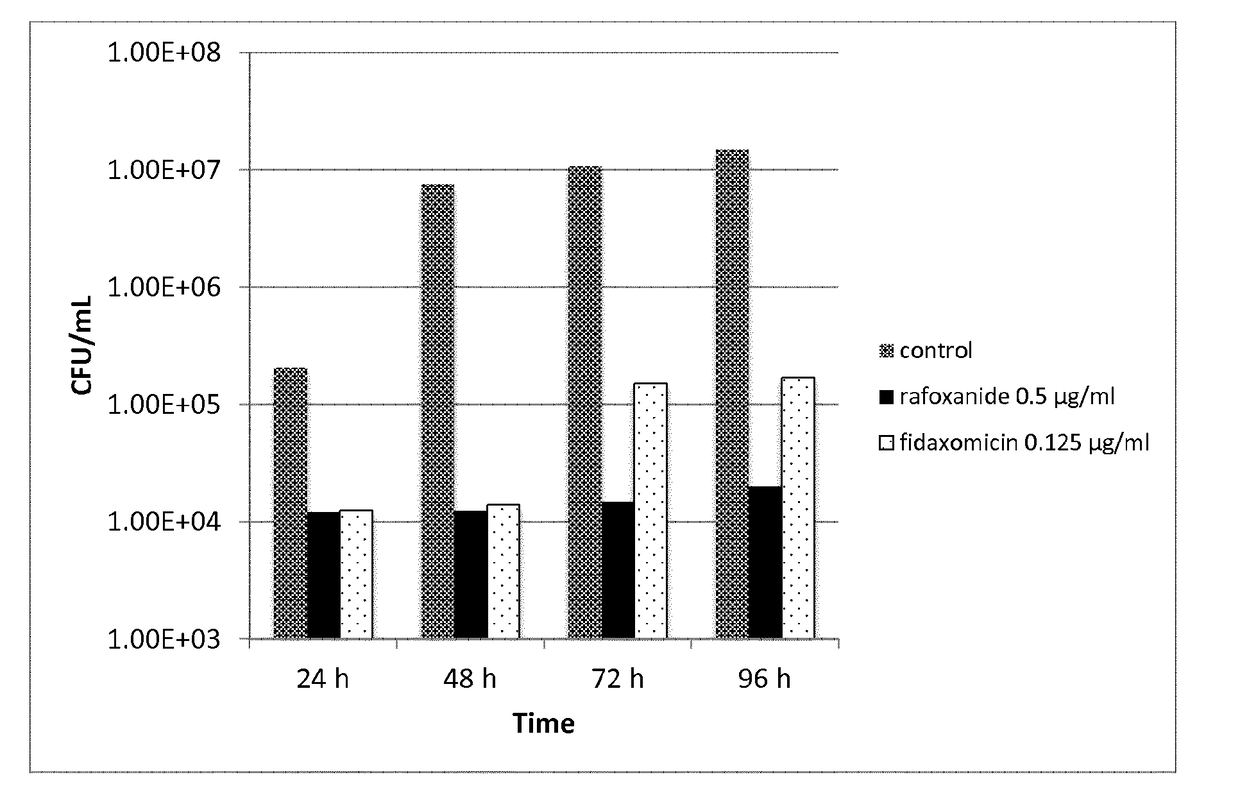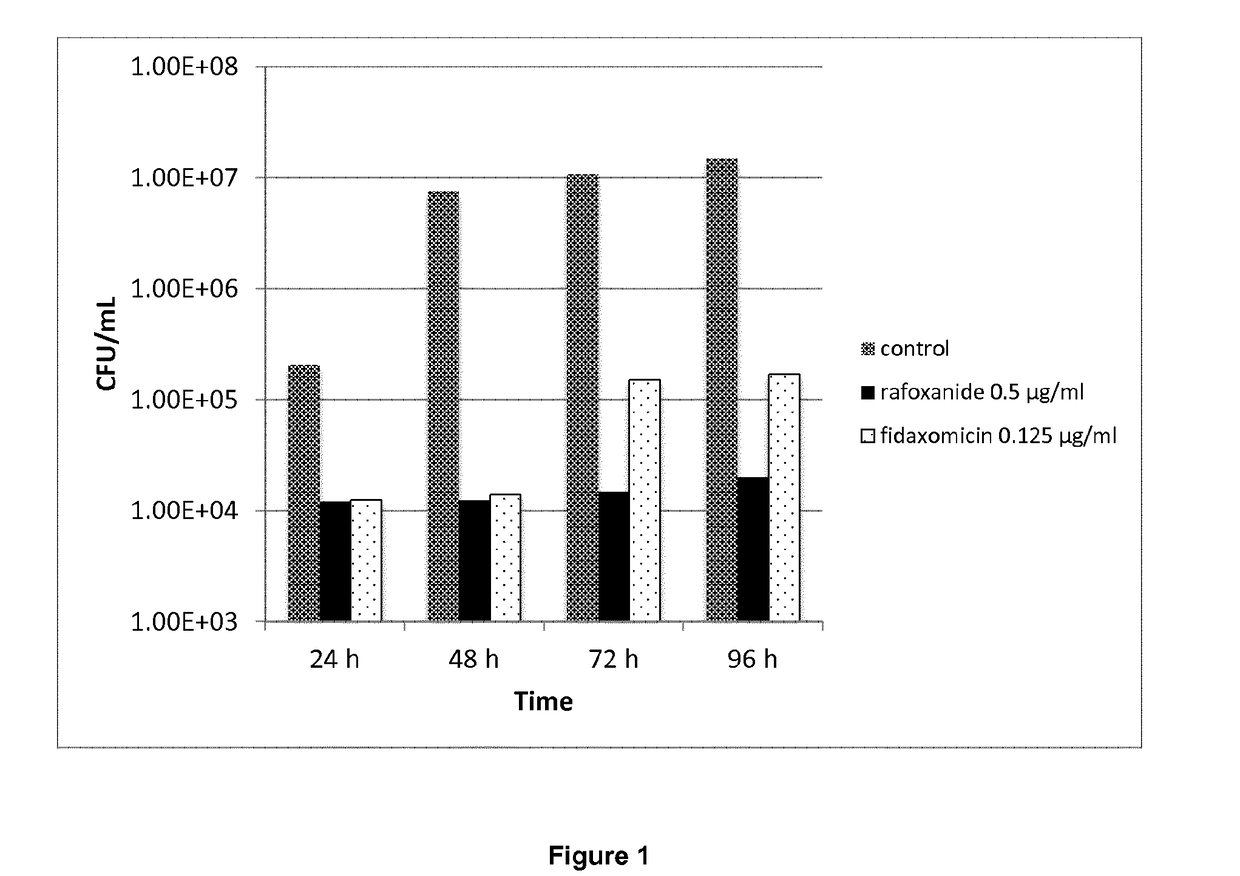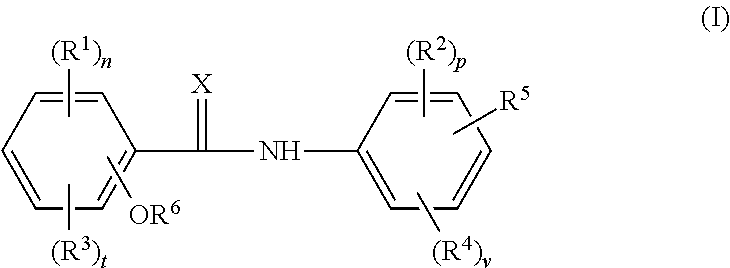Halogenated salicylanilides for treating clostridium infections
a technology of clostridium infection and salicylanilide, which is applied in the field of clostridium infection treatment with halogenated salicylanilides, can solve the problems of increased morbidity, increased incidence of complications requiring colectomy, and significant negative economic consequences of broiler flock health, so as to reduce the rate of developing antibiotic resistance and the effect of treating and/or preventing or reducing clostridium infection
- Summary
- Abstract
- Description
- Claims
- Application Information
AI Technical Summary
Benefits of technology
Problems solved by technology
Method used
Image
Examples
example 1
MIC Determinations
[0259]C. difficile MICs are determined according to CLSI guideline using microbroth dilution as described in “Methods for Antimicrobial Susceptibility Testing of Anaerobic Bacteria; Approved Standard—Eighth Edition” CLSI, ISBN: 1-56238-789-8″, except isovitalex was used in the place of lysed horse blood.
[0260]The media used for the C. difficile MIC tests was Brucella broth supplemented with hemin (5 μg / ml), vitamin K and Isovitalex (according to the manufacturer's instructions). Inoculated plates were incubated for 44 to 48 hours at 36° C. under anaerobic conditions (anaerobic chamber or anaerobic jar with gaspack).
[0261]The C. difficile strain ATCC 700057 was used as a reference control during the C. difficile MIC determinations. This strain has an expected MIC towards vancomycin of 1 ug / mL.
[0262]The results are shown in Tables 2 and 3.
TABLE 2MIC of clinical isolates of C. difficileagainst niclosamide and vancomycinC. difficile isolateNiclosamide (ug / mL)Vancomycin...
example 2
[0264]Table 4 compares the properties of niclosamide with those of vancomycin, metronidazole, fidaxomicin. The data shown in Table 4 was obtained from published data together with data from the examples herein.
TABLE 4VancomycinMetronidazoleFidaxomicinNiclosamideClassGlycopeptideNitroimidazoleMacrolideHalogenated salicylanilideDosingTID, oralTID, oral or IVBID, oral1-4 times daily, oralMIC90 (μg / mL) 2a 1a0.5a0.06-0.25bHighest MIC observed16a>32a1 0.5(μg / mL)Spectrum of activityGram+Gram+ / −Gram+Gram+Side effectscBladder pain,Abdominal orNausea,Nausea, retching,bloating, bloodystomach cramps,vomiting,abdominal painurine, painfuldizziness,abdominal pain,urination, fever,heartburn.gastrointestinaldry mouth, irregularSpinning sensation.hemorrhage, anemia,heartbeat, loss ofTrouble sleeping,neutropeniaappetite, moodcongestion, drychanges, musclemouthpain or cramps,numbness, rapidweight gain,shortness ofbreath, tirednessFootnotes:aANTIMICROBIAL AGENTS AND CHEMOTHERAPY, June 2002, p. 1647-16...
example 3
Additional MIC Determinations
[0265]The MIC of the halogenated salicylanilides clioxanide, closantel, oxyclozanide, rafoxanide and tribromsalan was determined against 24 clinical isolate strains of C. difficile. Fidaxomycin, metronidazole and vancomycin were used as comparator compounds in the study. The comparator compounds represent the antibiotics most often used in current treatments of C. difficile infections.
[0266]Stock solutions of the test compounds and comparators were made in DMSO at a concentration of 1 mg / mL.
Microorganisms
[0267]The C. difficile strains used are shown in Table 5:
TABLE 5NameMLSTNameMLST7-6011209ST0027-7363761ST0087-7150288ST0037-7200552ST0177-7154992ST1397-7150318ST0597-6778909ST0167-7150628ST0347-6870430ST0017-7149204ST0067-7104022ST1037-7116411ST0057-5085357ST0287-7150997ST0497-7124449ST0097-6854508ST01312055—12063—12060—12064—12061—12065—12062—12066—
Culture Medium
[0268]C. difficile strains were grown on Brucella blood agar+hemin+vitamin K [1], plates wer...
PUM
 Login to View More
Login to View More Abstract
Description
Claims
Application Information
 Login to View More
Login to View More - R&D
- Intellectual Property
- Life Sciences
- Materials
- Tech Scout
- Unparalleled Data Quality
- Higher Quality Content
- 60% Fewer Hallucinations
Browse by: Latest US Patents, China's latest patents, Technical Efficacy Thesaurus, Application Domain, Technology Topic, Popular Technical Reports.
© 2025 PatSnap. All rights reserved.Legal|Privacy policy|Modern Slavery Act Transparency Statement|Sitemap|About US| Contact US: help@patsnap.com



